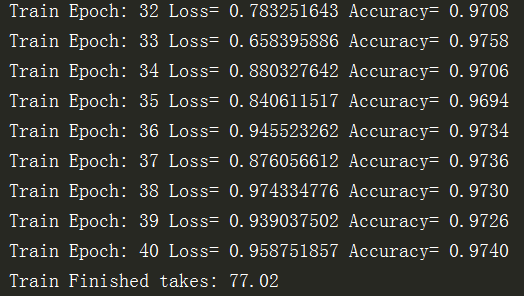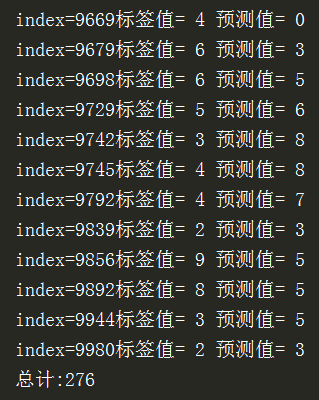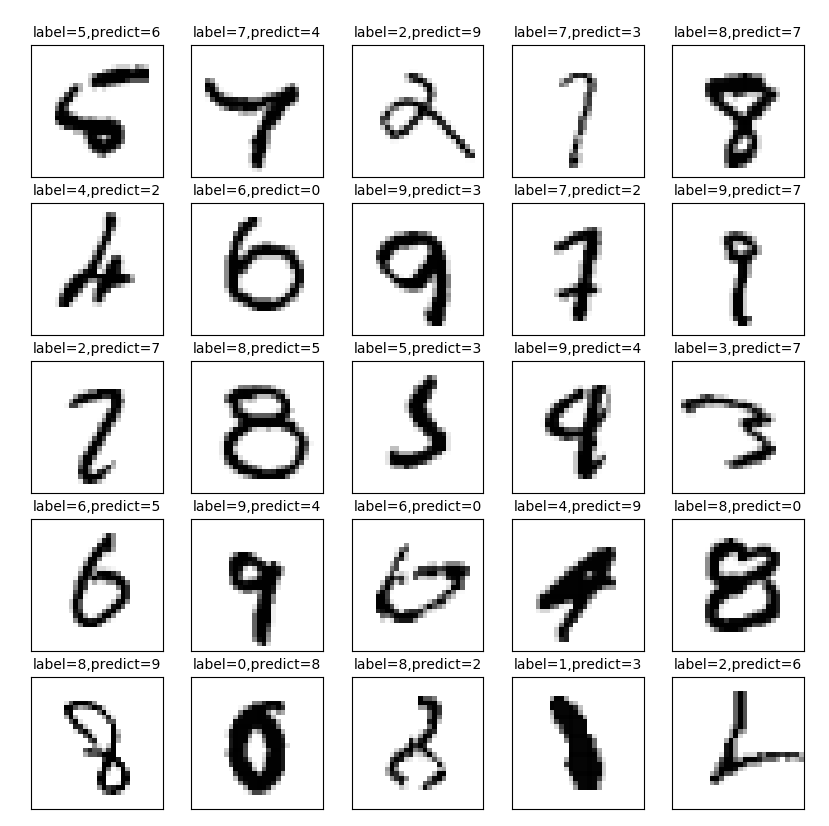一、单隐藏层神经网络构建与应用
主要内容:
1.1载入数据
1.2建立模型
1.3训练模型
1.4评估模型
1.5应用模型
1.1载入数据

1.2建立模型
1.2.1构建输入层
#定义标签数据占位符 x= tf.placeholder(tf.float32, [None, 784], name='X') #图片大小28*28 y= tf.placeholder(tf.float32, [None, 10], name='Y')
1.2.2构建隐藏层
H1_NN=256 #自定义隐藏层神经元数量 W1 = tf.Variable(tf.random_normal([784,H1_NN])) #全连接x1,x2... b1 = tf.Variable(tf.zeros([H1_NN])) #偏置项 Y1 = tf.nn.relu(tf.matmul(x,W1)+b1)
1.2.3构建输出层
W2 = tf.Variable(tf.random_normal([H1_NN,10])) b2 = tf.Variable(tf.zeros([10])) forward = tf.matmul(Y1, W2) + b2 pred=tf.nn.softmax(forward) #多分类预测结果
1.3训练模型
1.3.1定义损失函数、设置训练参数、选择优化器、定义准确率
loss_function = tf.reduce_mean(-tf.reduce_sum(y*tf.log(pred),reduction_indices=1)) #定义交叉熵损失函数 #设置训练参数 train_epochs = 40 #训练轮数 batch_size=50 #单次训练样本数(批次大小) total_batch= int(mnist.train.num_examples/batch_size)#一轮训练有多少批次 display_step=1 #显示粒度 learning_rate=0.01 #学习率 #选择优化器 optimizer = tf.train.AdamOptimizer(learning_rate).minimize(loss_function) #定义准确率 correct_prediction = tf.equal(tf.argmax(y,1),tf.argmax(pred,1)) accuracy = tf.reduce_mean(tf.cast(correct_prediction,tf.float32))#准确率,将布尔值转化为浮点数,并计算平均值
1.3.2训练过程

#记录训练开始时间 startTime = time() sess = tf.Session() sess.run(tf.global_variables_initializer()) for epoch in range(train_epochs): for batch in range(total_batch): xs, ys = mnist.train.next_batch(batch_size) # 读取批次数据 sess.run(optimizer,feed_dict={x:xs,y:ys}) # 执行批次训练 #total_batch个批次训练完成后,使用验证数据计算课差与准确率;验证集没有分批 loss,acc = sess.run([loss_function,accuracy],feed_dict={x:mnist.validation.images,y:mnist.validation.labels}) #打印训练过程中的详细信息 if (epoch+1) % display_step == 0: print("Train Epoch:",'%02d' %(epoch+1),"Loss=","{:.9f}".format(loss),"Accuracy=","{:.4f}".format(acc)) duration = time()-startTime #显示运行总时间 print("Train Finished takes:","{:.2f}".format(duration))
运行结果为:

分析原因,定义交叉熵损失函数时,有一个log项,log(0)引起的数据不稳定
# loss_function = tf.reduce_mean(-tf.reduce_sum(y*tf.log(pred),reduction_indices=1)) #定义交叉熵损失函数 #TensorFlow提供了softmax_cross_entropy_with_logits函数,用于避免因为log(0)值为NaN造成的数据不稳定 loss_function = tf.reduce_mean(tf.nn.softmax_cross_entropy_with_logits(logits=forward,labels=y)) #注意第一个参数是不做Softmax的前向计算结果
修改后,运行结果为:

从上述打印结果可以看出包含256个神经元的单隐层神经网络的分类性能比仅包含一个网络更优。
1.4评估模型
#使用测试集评估模型 accu_test = sess.run(accuracy,feed_dict={x:mnist.test.images,y:mnist.test.labels}) print("Test Accuracy:",accu_test)

1.5应用模型
1.5.1进行预测
#由于pred预测结果是one-hot编码格式,所以需要转换为0-9数字 prediction_result = sess.run(tf.argmax(pred,1),feed_dict={x:mnist.test.images}) print(prediction_result[0:10]) #查看预测结果中的前10项

1.5.2找出预测错误
compare_lists = prediction_result==np.argmax(mnist.test.labels,1) print(compare_lists) err_lists=[i for i in range(len(compare_lists)) if compare_lists[i]==False] print(err_lists, len(err_lists)) #最后一项即为多少个预测错了
 ...........
........... 
可见一共有279个预测错误,但这样返回预测错误的下标不够直观,接下来进行修改。
修改一:
#定义一个输出错误分类的函数 def print_predict_errs(labels, prediction): #标签列表,预测值列表 count = 0 compare_lists =(prediction==np.argmax(labels,1)) err_lists = [i for i in range(len(compare_lists)) if compare_lists [i]==False] for x in err_lists: print("index="+str(x) + "标签值=",np.argmax(labels[x]),"预测值=",prediction[x]) count += 1 print("总计:"+str(count)) print_predict_errs(labels=mnist.test.labels,prediction=prediction_result)
运行结果:

以文本显示,仍然不够直观,进一步修改。
修改二(+可视化):
对https://www.cnblogs.com/HuangYJ/p/11642475.html中6.1节可视化函数修改,以便只显示预测错误的样本

#可视化 def plot_images_labels_prediction(images,labels,prediction,num=10): #图像列表,标签列表,预测值列表,从第index个开始显示 , 缺省一次显示10幅 j = 0 fig = plt.gcf() #获取当前图表,get current figure fig.set_size_inches(10,12) #1英寸等于2.54cm compare_lists = prediction_result == np.argmax(mnist.test.labels, 1) err_lists = [i for i in range(len(compare_lists)) if compare_lists[i] == False] if num > 25: num = 25 #最多显示25个子图 for i in range(0, num): ax = plt.subplot(5,5,i+1) #获取当前要处理的子图 ax.imshow(np.reshape(images[err_lists[j]], (28, 28)),cmap='binary') # 显示第index个图像 title = "label=" + str(np.argmax(labels[err_lists[j]]))# 构建该图上要显示的 if len(prediction)>0: title += ",predict="+ str(prediction[err_lists[j]]) ax.set_title(title, fontsize=10) #显示图上title信息 ax.set_xticks([]) #不显示坐标轴 ax.set_yticks([]) j += 1 plt.show() plot_images_labels_prediction(mnist.test.images,mnist.test.labels,prediction_result,25) #最多显示25张
显示前25个预测错误的样本,预测结果为:

全部代码为:

#Created by:Huang #Time:2019/10/15 0015. import tensorflow as tf import tensorflow.examples.tutorials.mnist.input_data as input_data import matplotlib.pyplot as plt import numpy as np from time import time mnist = input_data.read_data_sets("MNIST_data/",one_hot=True) #定义标签数据占位符 x= tf.placeholder(tf.float32, [None, 784], name='X') #图片大小28*28 y= tf.placeholder(tf.float32, [None, 10], name='Y') #隐藏层 H1_NN=256 #自定义隐藏层神经元数量 W1 = tf.Variable(tf.random_normal([784,H1_NN])) #全连接x1,x2... b1 = tf.Variable(tf.zeros([H1_NN])) #偏置项 Y1 = tf.nn.relu(tf.matmul(x,W1)+b1) #输出层 W2 = tf.Variable(tf.random_normal([H1_NN,10])) b2 = tf.Variable(tf.zeros([10])) forward = tf.matmul(Y1, W2) + b2 pred=tf.nn.softmax(forward) #多分类预测结果 # loss_function = tf.reduce_mean(-tf.reduce_sum(y*tf.log(pred),reduction_indices=1)) #定义交叉熵损失函数 #TensorFlow提供了softmax_cross_entropy_with_logits函数,用于避免因为log(0)值为NaN造成的数据不稳定 loss_function = tf.reduce_mean(tf.nn.softmax_cross_entropy_with_logits(logits=forward,labels=y)) #注意第一个参数是不做Softmax的前向计算结果 #设置训练参数 train_epochs = 40 #训练轮数 batch_size=50 #单次训练样本数(批次大小) total_batch= int(mnist.train.num_examples/batch_size)#一轮训练有多少批次 display_step=1 #显示粒度 learning_rate=0.01 #学习率 #选择优化器 optimizer = tf.train.AdamOptimizer(learning_rate).minimize(loss_function) #定义准确率 correct_prediction = tf.equal(tf.argmax(y,1),tf.argmax(pred,1)) accuracy = tf.reduce_mean(tf.cast(correct_prediction,tf.float32))#准确率,将布尔值转化为浮点数,并计算平均值 #记录训练开始时间 startTime = time() sess = tf.Session() sess.run(tf.global_variables_initializer()) for epoch in range(train_epochs): for batch in range(total_batch): xs, ys = mnist.train.next_batch(batch_size) # 读取批次数据 sess.run(optimizer,feed_dict={x:xs,y:ys}) # 执行批次训练 #total_batch个批次训练完成后,使用验证数据计算课差与准确率;验证集没有分批 loss,acc = sess.run([loss_function,accuracy],feed_dict={x:mnist.validation.images,y:mnist.validation.labels}) #打印训练过程中的详细信息 if (epoch+1) % display_step == 0: print("Train Epoch:",'%02d' %(epoch+1),"Loss=","{:.9f}".format(loss),"Accuracy=","{:.4f}".format(acc)) duration = time()-startTime #显示运行总时间 print("Train Finished takes:","{:.2f}".format(duration)) #使用测试集评估模型 accu_test = sess.run(accuracy,feed_dict={x:mnist.test.images,y:mnist.test.labels}) print("Test Accuracy:",accu_test) #模型预测 #由于pred预测结果是one-hot编码格式,所以需要转换为0-9数字 prediction_result = sess.run(tf.argmax(pred,1),feed_dict={x:mnist.test.images}) print(prediction_result[0:10]) #查看预测结果中的前10项 # #找出预测错误 # compare_lists = prediction_result==np.argmax(mnist.test.labels,1) # print(compare_lists) # # err_lists=[i for i in range(len(compare_lists)) if compare_lists[i]==False] # print(err_lists, len(err_lists)) #最后一项即为多少个预测错了 #定义一个输出错误分类的函数 # def print_predict_errs(labels, prediction): #标签列表,预测值列表 # count = 0 # compare_lists =(prediction==np.argmax(labels,1)) # err_lists = [i for i in range(len(compare_lists)) if compare_lists [i]==False] # for x in err_lists: # print("index="+str(x) + "标签值=",np.argmax(labels[x]),"预测值=",prediction[x]) # count += 1 # print("总计:"+str(count)) # print_predict_errs(labels=mnist.test.labels,prediction=prediction_result) #可视化 def plot_images_labels_prediction(images,labels,prediction,num=10): #图像列表,标签列表,预测值列表,从第index个开始显示 , 缺省一次显示10幅 j = 0 fig = plt.gcf() #获取当前图表,get current figure fig.set_size_inches(10,12) #1英寸等于2.54cm compare_lists = prediction_result == np.argmax(mnist.test.labels, 1) err_lists = [i for i in range(len(compare_lists)) if compare_lists[i] == False] if num > 25: num = 25 #最多显示25个子图 for i in range(0, num): ax = plt.subplot(5,5,i+1) #获取当前要处理的子图 ax.imshow(np.reshape(images[err_lists[j]], (28, 28)),cmap='binary') # 显示第index个图像 title = "label=" + str(np.argmax(labels[err_lists[j]]))# 构建该图上要显示的 if len(prediction)>0: title += ",predict="+ str(prediction[err_lists[j]]) ax.set_title(title, fontsize=10) #显示图上title信息 ax.set_xticks([]) #不显示坐标轴 ax.set_yticks([]) j += 1 plt.show() plot_images_labels_prediction(mnist.test.images,mnist.test.labels,prediction_result,25) #最多显示25张
